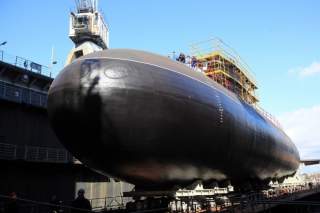Exposed: Russia's Master Plan for Its Next Class of Deadly Submarines
Moscow's next submarines could pack quite a punch--and be a little cheaper in the process.
Russia’s next-generation Project Husky-class nuclear attack boats will likely be designed so that it will maximize commonality with a next-generation successor to the Project 955A Borei-class ballistic missile submarines.
“The fifth-generation submarine project is being actively discussed,” Alexei Rakhmanov, president of the United Shipbuilding Corporation told the Moscow-base TASS News Agency. “Various preliminary requirements specifications are being elaborated. It will be absolutely different from the point of view of physical fields. It will be a commonality-based submarine combining key elements of strategic and multi-purpose submarines.”
Rakhamov told the news agency that the new vessels “will be distinguished by its weapons.” Russian designer are trying to maximize commonality between the different submarine classes to reduce cost as much as possible. Indeed, Moscow seems to be following the same pattern as the United States Navy, which is leveraging as much technology as possible from the Virginia-class attack submarine to develop the new Ohio Replacement Program ballistic missile submarine. However, it is possible that Russia might go a step further and simply insert ballistic missile launch section to an attack submarine design. Indeed, the world’s very first boomer, USS George Washington (SSBN-598), was originally laid-down as a Skipjack-class attack sub before an new hull section was added in during construction.
It was previously reported that the Husky-class would come in two versions—which are being developed by the Malakhit Design Bureau—that would be based on a common hull design. The primary difference will be in the two vessels’ weapon systems—the “interceptor” variant will not feature tubes to carry long-range anti-ship or cruise missiles. That version of submarine is expected to replace Project 971 Shchuka-B (NATO: Akula), the Project 945 Sierra and the remaining Project 671RTM Shchuka-class (NATO: Victor III) boats. The SSGN variant will replace the Project 949A Antey-class. The SSGN variant will also be armed with hypersonic Zircon cruise missiles. But this report of a ballistic missile submarine variant is new.
The Russians are likely using the Project 855M Yasen-class and elements of the Borei-class as a starting point, but the new submarines are likely going to be smaller and cheaper than their Soviet-designed predecessors. Indeed, there are indications that Moscow will be extensively leveraging automation technologies developed for the Project 705 Lira-class attack submarine—better known in the West as the Alfa-class—for the new boats.
Russian analysts estimate that the next-generation submarines will displace no more than about 6,000-tons—though obviously a ballistic missile submarine variant would be much larger. That could mean that another Soviet innovation might make a comeback—liquid metal cooled reactors. The Lira and several other Soviet designs used lead-bismuth cooled reactors, which produce much more power and are much more compact than pressurized water reactors. However, the disadvantage is that liquid-metal cooled reactors cannot be shut down and require specialized port facilities.
Russia will also incorporate composite structures in its next-generation follow-on to the Project 855M Yasen-class in the 2020s. The next-generation Russian nuclear submarines may use composite structures in an attempt to drastically reduce their acoustical signatures. But while the United States has used composite materials to reduce the weight, complexity and cost of parts for the Virginia-class submarine, the Russian efforts are far more ambitious. But this wouldn’t be the first time Moscow has experimented with novel materials to build submarines. Before its collapse, the Soviet Union pioneered the use of titanium hulls to increase the hydrodynamic performance of its boats.
“These are new multi-layer composite materials. . . . Their structure and composition reduce the sonar signals that are reflected from a submarine, isolate working mechanisms from vibrations, and so on,” said Valeriy Polovinkin, an adviser to the general director of the Krylov State Research Center, in an interview with the Russian-language daily Izvestia. “The opponent just will not get the required level of signal reflected from the submarine as the composite material has a high internal loss factor, or sound absorption properties can change when vibration occurs, completely preventing the spread of vibrational energy.”
The Russians hope to use composite materials for everything from the hull coating to the dive planes, rudders, stabilizers, propellers (or pumpjet propulsors), drive shafts and possibly even the hulls themselves. If the technology works, composite materials would greatly reduce the weight of various structures, increase the boat’s reliability and reduce operating costs. That’s because composites don’t corrode and thus wouldn’t need to be painted, Polovinkin said—reducing maintenance costs. Moreover, composite structures should simplify manufacturing by reducing part counts.
The new composite materials are still in testing, but Russia will test its first composite propeller design in 2018. “This is one of our institute’s most promising projects,” Polovinkin said. “This trend reduces vibration in the blades and increases the efficiency of the screw. These various effects will help improve the ship’s acoustic signature.”
Dave Majumdar is the defense editor for the National Interest. You can follow him on Twitter: @davemajumdar.
Image: Admiralty Shipyards

